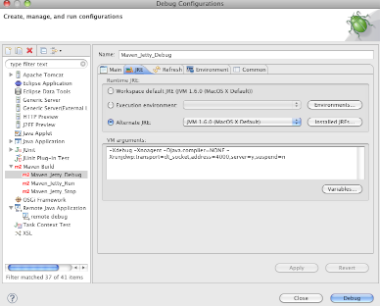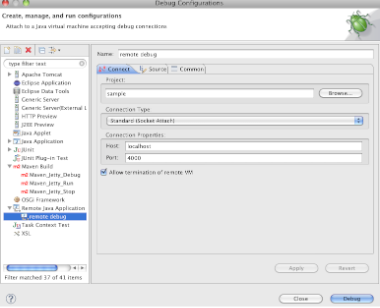ORM的選擇很多,雖然JEE訂出了一個規格JPA,但之前並不喜歡使用,主要是因為相較其他原生的library像Hibernate, Eclipse Link等,JPA在實際開發上並不如其他Library來得方便,沒有像Hibernate的Criteria這類API就令我很感冒,所以在ORM的Demo裡一直沒有把JPA納入,多半使用的都還是Hibernate。
直到JPA2規格訂完,Hibernate也出了Stable的版本,想想也該納入看一看了。Hibernate與JPA所訂的EntityManager差異還不小,從中轉換還是要看一下JPA2的Spec,但我發現花較多時間的是在Spring的Configuration,要設定的部份較原來的純Hibernate要多出不少,而且有些我看了還是有些疑惑,看來單單有關Configuration就要寫上幾篇筆記了。
下列是基本的Spring Configurations:
applicationContext.xml:
<? xml version= "1.0" encoding= "UTF-8" ?>
< beans xmlns = "http://www.springframework.org/schema/beans"
xmlns:xsi = "http://www.w3.org/2001/XMLSchema-instance" xmlns:context = "http://www.springframework.org/schema/context"
xmlns:util = "http://www.springframework.org/schema/util" xmlns:p = "http://www.springframework.org/schema/p"
xmlns:tx = "http://www.springframework.org/schema/tx" xmlns:aop = "http://www.springframework.org/schema/aop"
xsi:schemaLocation = "http://www.springframework.org/schema/beans http://www.springframework.org/schema/beans/spring-beans.xsd
http://www.springframework.org/schema/context http://www.springframework.org/schema/context/spring-context.xsd
http://www.springframework.org/schema/tx http://www.springframework.org/schema/tx/spring-tx.xsd
http://www.springframework.org/schema/aop http://www.springframework.org/schema/aop/spring-aop.xsd
http://www.springframework.org/schema/util http://www.springframework.org/schema/util/spring-util.xsd ">
< context:property-placeholder location = "classpath:system.properties" />
< bean id = "dataSource" class = "com.mchange.v2.c3p0.ComboPooledDataSource">
< property name = "driverClass" value = "${jdbc.driverClass}" />
< property name = "jdbcUrl" value = "${jdbc.url}" />
< property name = "user" value = "${jdbc.user}" />
< property name = "password" value = "${jdbc.password}" />
< property name = "autoCommitOnClose" value = "${jdbc.autoCommitOnClose}" />
</ bean>
< bean id = "entityManagerFactory"
class = "org.springframework.orm.jpa.LocalContainerEntityManagerFactoryBean">
< property name = "persistenceXmlLocation" value = "org/elliot/dao/jpaimpl/persistence.xml" />
< property name = "dataSource" ref = "dataSource" />
< property name = "jpaVendorAdapter">
< bean class = "org.springframework.orm.jpa.vendor.HibernateJpaVendorAdapter">
< property name = "database" value = "${hibernate.database}" />
< property name = "showSql" value = "${hibernate.show_sql}" />
< property name = "generateDdl" value = "${hibernate.generate_ddl}" />
</ bean>
</ property>
< property name = "jpaPropertyMap">
< props>
< prop key ="hibernate.cache.provider_class" > org.hibernate.cache.HashtableCacheProvider</ prop >
</ props>
</ property>
</ bean>
< bean id = "entityManager"
class = "org.springframework.orm.jpa.support.SharedEntityManagerBean">
< property name = "entityManagerFactory" ref = "entityManagerFactory" />
</ bean>
< bean id = "transactionManager" class = "org.springframework.orm.jpa.JpaTransactionManager">
< property name = "entityManagerFactory" ref = "entityManagerFactory" />
< property name = "dataSource" ref = "dataSource" />
</ bean>
< tx:annotation-driven transaction-manager = "transactionManager"
proxy-target-class= "true" />
< context:annotation-config />
< context:component-scan base-package = "org.elliot.dao.jpaimpl,org.elliot.service" />
</ beans>
persistence.xml
< persistence xmlns = "http://java.sun.com/xml/ns/persistence"
xmlns:xsi = "http://www.w3.org/2001/XMLSchema-instance"
xsi:schemaLocation = "http://java.sun.com/xml/ns/persistence http://java.sun.com/xml/ns/persistence/persistence_2_0.xsd"
version= "2.0" >
< persistence-unit name = "Master" transaction-type = "RESOURCE_LOCAL">
< class > org.elliot.domain.Master</ class >
< exclude-unlisted-classes/>
</ persistence-unit>
</ persistence>
system.properties:
#h2database configurations
jdbc.driverClass= org.h2.Driver
jdbc.url = jdbc:h2:~/test
#jdbc.url=jdbc:h2:tcp://localhost/~/test
jdbc.user= sa
jdbc.password=
jdbc.autoCommitOnClose= true
hibernate.database= H2
hibernate.dialect = org.hibernate.dialect.H2Dialect
hibernate.show_sql= true
hibernate.format_sql= true
hibernate.generate_statistics= true
hibernate.hbm2ddl.auto= create
hibernate.cache.use_second_level_cache= true
hibernate.generate_ddl= true
其中要注意的是Spring: entityManagerFactory的persistenceXmlLocation,基本上應是要指到META-INF下,這裡只是方便測試才搬出來,如果希望在其他不用Spring的案子使用要記得放回去,至於其他Spring還有許多相關的Configuration如loadTimeWeaver之類的就還在研究了。。。



